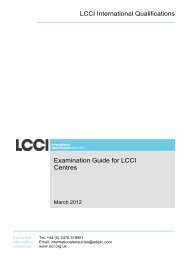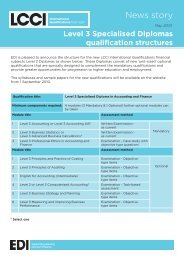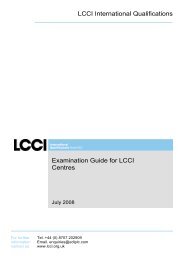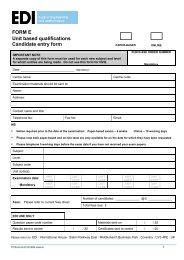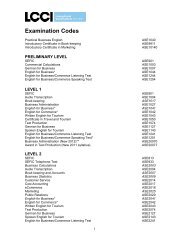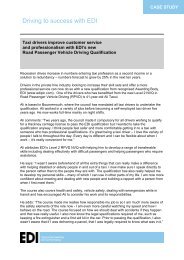Guide to Examination Success - LCCI International Qualifications
Guide to Examination Success - LCCI International Qualifications
Guide to Examination Success - LCCI International Qualifications
You also want an ePaper? Increase the reach of your titles
YUMPU automatically turns print PDFs into web optimized ePapers that Google loves.
Calculate/<br />
Compute<br />
Just as it says – you have <strong>to</strong> do the maths.<br />
Demonstrate/<br />
Show<br />
Prepare<br />
Analyse<br />
Examine<br />
Classify<br />
Compare<br />
and Contrast<br />
Summarise<br />
Discuss<br />
Review<br />
Interpret<br />
Evaluate/<br />
Assess<br />
Suggest/<br />
Recommend<br />
You need <strong>to</strong> show or prove something <strong>to</strong> be true, beyond any doubt, or show that it<br />
applies in the situation described, by giving evidence.<br />
Mostly used in book-keeping and accounting - when this verb is used, there is a fair<br />
amount of data (often numerical) in the question. You need <strong>to</strong> take the relevant data,<br />
process it (perhaps by calculation, but often just by rearranging it), then provide it in a<br />
particular format; for example, preparing a balance sheet from the trial balance.<br />
This is one of the more difficult words. This is asking you <strong>to</strong> examine something in<br />
detail; break it down in<strong>to</strong> smaller parts and give detailed explanations with examples if<br />
appropriate; often opinions rather than facts.<br />
Inspect carefully or look at in detail; investigate.<br />
This is asking you <strong>to</strong> arrange or put things in<strong>to</strong> groups or classes. You will need <strong>to</strong><br />
explain why you have put each in a particular list and not one of the others.<br />
Explaining how things are similar and how they are different (similarities and<br />
differences). For example, compare and contrast a pig and a dog – they both have four<br />
legs (similarity) but one barks and the other grunts (difference).<br />
Giving the important ideas in brief.<br />
This can be a tricky one. In order <strong>to</strong> discuss something, there needs <strong>to</strong> be an ‘argument’<br />
i.e, you need two or more differing or opposing viewpoints. Also, any discussion<br />
should, if possible, end with a conclusion. Think about: advantages, disadvantages,<br />
and conclusion. Or: reasons why, reasons why not and conclusion. It is also possible<br />
<strong>to</strong> ‘discuss’ one viewpoint. For example you may be asked <strong>to</strong> ‘discuss the advantages<br />
of…’. Does this mean you have <strong>to</strong> do the disadvantages as well? No - simply go through<br />
the advantages, saying whether they apply in this situation, or whether they are each a<br />
major advantage or a relatively minor one.<br />
Giving an overview of ideas and establishing their qualities and features.<br />
Can be challenging - you need <strong>to</strong> explain your view of facts and ideas and how they<br />
relate <strong>to</strong> one another. In some sense, translating from one form of words <strong>to</strong> another.<br />
‘Interpret’ is often the second stage of ‘analyse’.<br />
Another tricky one – this is asking you <strong>to</strong> judge the worth, importance or value of<br />
something, whether in monetary terms or not. Think of this as a higher level discussion.<br />
As it says – telling them what <strong>to</strong> do. This is normally the last requirement in a question<br />
because you first need <strong>to</strong> identify, explain and evaluate before you can recommend or<br />
suggest a way forward.<br />
Practical exam tips on the next page...<br />
www.lcci.org.uk<br />
www.lcci.org.uk




